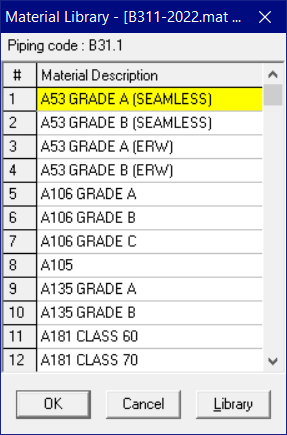Material
For a project, a piping material engineer usually produces different material lists for different process and utility systems based on process design conditions, list of components, fluid type (corrosivity, viscosity), end conditions and temperature, pressure and size ranges.
As a result, a piping system will have its materials list, which will specify the materials a stress analyst will have to define inside CAEPIPE before analysis. CAEPIPE is so flexible that it allows each element (such as a pipe, beam, elbow, valve, jacket, bellows, etc.) to have its own material definition.
Once you define and name a material type, you type in that name on the Layout window under the column “Matl” to specify the material for an element. A material may be metallic or FRP. You need to obtain properties (density, Poisson’s ratio, Young’s modulus, mean coefficient of thermal expansion and allowable stress as a function of temperature) for a new material not found in the supplied libraries. You will need properties for at least two temperatures (reference and design) for each material you define. Subsequently, the temperatures you specify for an element that uses this material must fall within this temperature range.
The material name you specify on the layout applies to the piping element on that row. For jacketed piping, you must specify two materials - one for the core pipe (on the Layout window), and the other for the jacket pipe in its own dialog. The material you specify for a bend, a jacketed bend, and for a miter bend applies only to that specific element on that input row.
There are two ways in which you can define materials:
1. By defining a material inside the CAEPIPE model, or
2. By picking a material from an existing material library.
For the sake of convenience, we suggest that you create a separate material library for your pipe stress project so that you can share it with your team members.
Below, you will see how to create a material inside a model and how to create a new or modify an existing material library.
Define a Material inside a CAEPIPE model
From the Layout window, click on “Matl” on the header row (or select Materials from the Misc menu, Ctrl+Shift+M).

The List window for materials is shown.
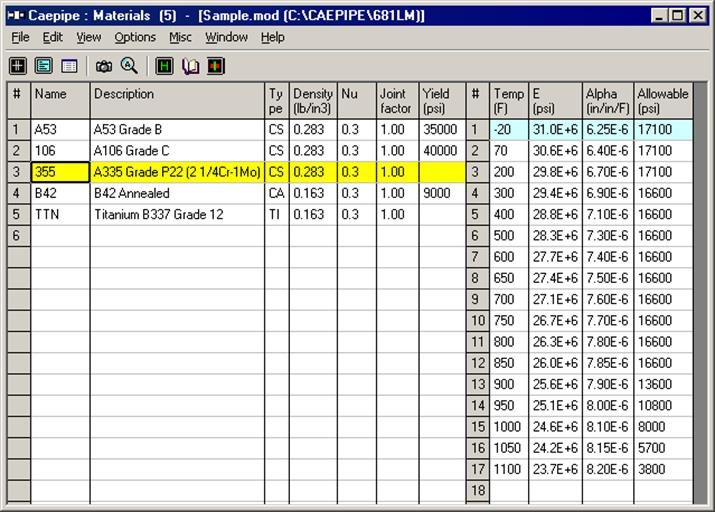
In the Material List window, you can edit inside both panes - the left pane contains Name, Description, Type of material, Density, Poisson’s ratio (nu), Joint factor etc. and the right pane contains material properties (usually Modulus of Elasticity E, mean Coefficient of Linear thermal expansion [Alpha], not instantaneous coefficient nor thermal expansion per unit length, and the code-specific Allowable stress) as a function of Temperature. CAEPIPE requires “Weight Density” to be input in lbf/in3 or kgf/m3 and NOT its mass density. While entering the temperature-dependent material properties, you need not enter temperatures in an ascending order, although recommended. CAEPIPE will sort the entries later.
After you are done entering properties for one material, be sure to press Enter when the cursor is in the left pane, to move it to the next row so you can start entering the next material. You can insert, copy & paste, delete and edit any material (see under Edit menu).
These panes may change depending on the piping code chosen. For example, for the Swedish and Norwegian codes, the following window is displayed. This window contains additional columns for Tensile strength and instead of one Joint factor, it has Longitudinal and Circumferential joint factors.
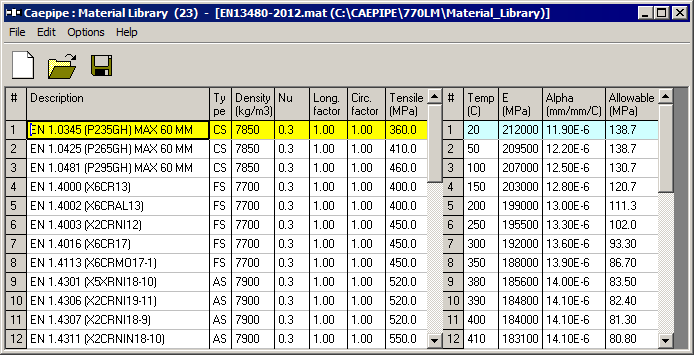
The European (EN 13480) code has a column for Tensile strength and temperature-dependent properties have an additional column for fCR (allowable creep stress).
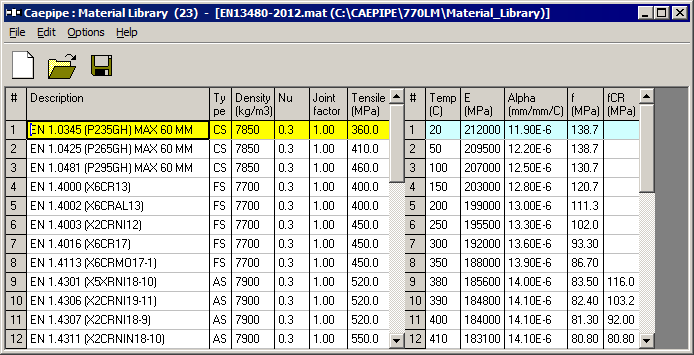
To Input a New Material
You can input a new material in three ways:
1. Start typing directly into the fields in the Materials List window.
2. Input through dialogs (shown below for some but not all piping codes).
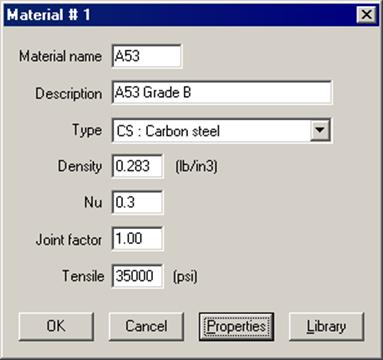
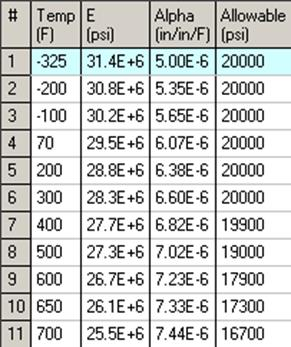
For the Swedish and Norwegian piping codes, the Material dialog has Longitudinal and Circumferential joint factors and a Tensile strength field.
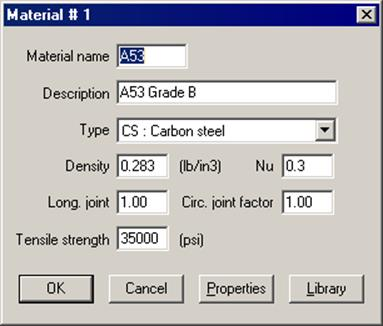
For the European (EN 13480) code, the Material dialog has a single Joint factor and a Tensile strength field, while the properties window has fCR (creep stress allowable).
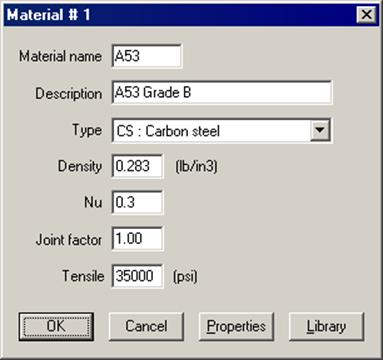
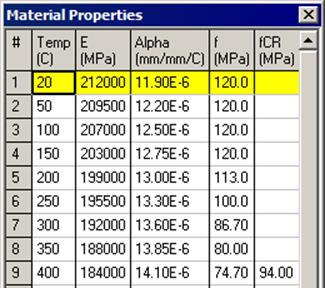
3. Pick a material from an existing material library (supplied with CAEPIPE or your own). Click on the Library button on the toolbar to open the library:

(or select Library command under the File menu):
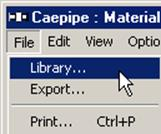
You will have to open a library file first if it was not previously opened. Select the one of interest. Note that the libraries with filenames starting with B311 and B313 with year later than 2010 (e.g., B313-2012.mat) have approx. 200 materials each (from the respective piping code).
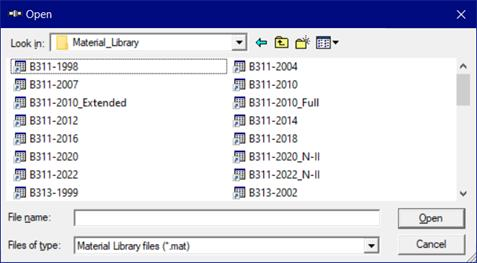
You can select a material from the opened library by double clicking on it or highlighting it and clicking on OK.
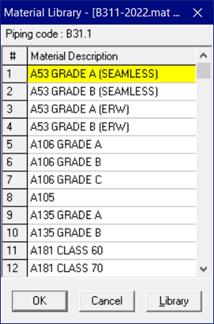
Name
Type a Material name, up to five(5) alpha-numeric characters.
Description
Type a description for the material, up to 31 characters.
Type
|
AL
|
for
|
Aluminum
|
|
AS
|
for
|
Austenitic Stainless Steel
|
|
CA
|
for
|
Copper alloys annealed
|
|
CC
|
for
|
Copper alloys cold worked
|
|
CS
|
for
|
Carbon Steel
|
|
FR
|
for
|
Fiber Reinforced Plastic piping
|
|
FS
|
for
|
Ferritic steel
|
|
NA
|
for Nickel alloys 800, 800H, 825
| |
|
SS
|
for
|
Stainless Steel
|
|
TI
|
for
|
Titanium
|
|
CI
|
for
|
Cast Iron
|
|
PC
|
for
|
Polyvinyl Chloride
|
|
PE
|
for
|
Polyethylene
|
|
PH
|
for
|
High-Density Polyethylene
|
|
PL
|
for
|
Low-Density Polyethylene
|
|
PO
|
for
|
Other types of Plastics
|
|
PP
|
for
|
Polypropylene
|
|
PS
|
for
|
Polystyrene
|
|
PT
|
for
|
Polyethylene Terephthalate
|
These material types are used in calculation of the Y factor for allowable pressure at high temperatures for certain piping codes. Swedish and Norwegian piping codes also use it for calculating allowable expansion stress range. These codes also need tensile strength.
For Fiber Reinforced Plastic piping, you need to select the material type “FR” to enter FRP material properties. More information can be found under the section Fiber Reinforced Plastic Piping in this manual.
Density
Density of the material is used to calculate weight load and also mass for dynamic analysis. CAEPIPE requires “Weight Density” to be input in lbf/in3 or lbf/ft3 or kgf/m3 or gf/cm3 and NOT its mass density. Whenever mass is required for a calculation as in the case of forming Mass matrix for dynamic analysis, or in calculating inertia force as (mass x acceleration) for static seismic analysis, CAEPIPE internally computes the mass to be equal to (weight / g-value).
The Poisson’s ratio (Nu) defaults to 0.3 if not input.
Joint factor
The joint factor is the longitudinal weld joint factor used to calculate allowable pressure. For Swedish and Norwegian piping codes, a circumferential joint factor is also input to calculate longitudinal pressure stress.
Tensile strength and Yield Strength
For Swedish, Norwegian and European (EN13480) piping codes, tensile strength is used in the calculation of the allowable expansion stress range. For Stoomwezen piping code, tensile strength is used in the calculation of hot allowable stress.
For B31.1, B31.3 and B31.9, for materials with a minimum tensile strength of over 70 ksi (480 MPa), Sc and Sh values are taken as no greater than 20 ksi (140 MPa).
For B31.3 or B31.12 piping codes, yield is used in the calculation of sustained plus occasional allowable stress when the temperature is > 4800 C or 8000 F.
Note: When this field Yield is left BLANK for B31.3, then CAEPIPE will compute the Yield Strength of the material by multiplying the Allowable Stress at the minimum temperature (at which the material properties are entered in CAEPIPE stress model) with a factor of 1.5 (=3/2). This is because; the allowable stress for material below creep is generally 2/3 of Yield Strength.
For the NONE piping code, the Material dialog has the following additional fields to input S-N Fatigue Curve Factors.
In case the user is performing a Random Vibration analysis, the SN Curve (log-log) parameters are required for fatigue evaluation. For details on SN curve, please refer to the Section titled “Dynamic Analysis” in CAEPIPE Technical Reference Manual.
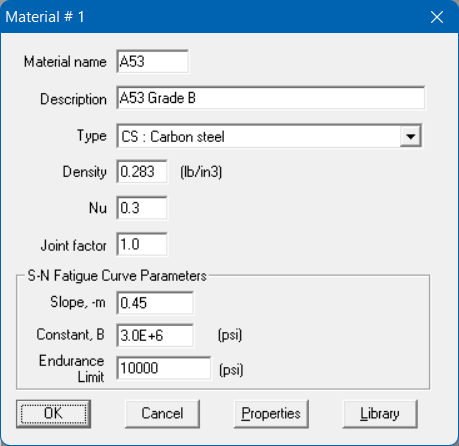
Slope, -m 
Input the slope m (must be a positive integer) of the S-N curve, -m. From two known data points (N1, S1) and (N2, S2), the slope of the S-N curve m can be calculated as:

Constant, B 
The constant "B" is the fatigue strength coefficient and can be calculated from any known data point and slope m, as
Endurance Limit
Input the endurance limit of the material. The endurance limit is the stress limit below which there is no fatigue failure.
To create or modify a material library
CAEPIPE offers you flexibility in creating your own material libraries (user-defined libraries). That way, you do not feel restricted by the offered choices in materials and can continually keep updating the material libraries with your own materials. To create a library: From the Main window, select File > New and click on Material Library.
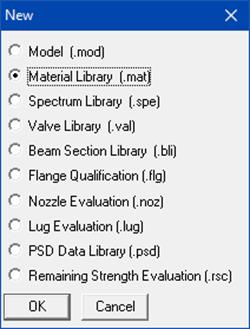
A List window for materials is shown.
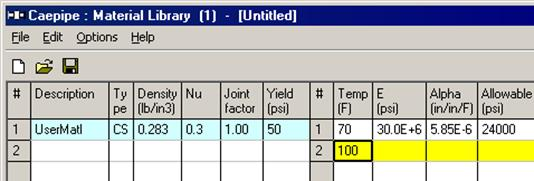
You must select a piping code first, using the menu command Options > Piping code, before you start entering properties.
You can, as before, start typing directly into the fields, or enter properties through a dialog. The only difference is that materials in the library do not have names whereas those in a model have names.
After you are done entering materials, you must save to a material library file by using the File > Save command.
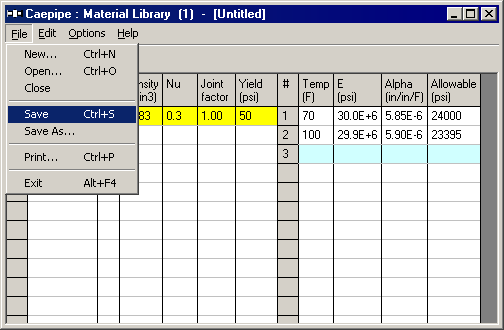
Give the file a suitable name. The file will be saved with a .mat extension.
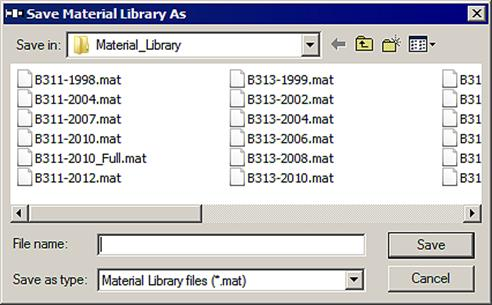
Note: It is also possible to Import/Export the material library through a ASCII Material Batch Library (.mlb) file. See the section titled Import/Export Material Library in Appendix A of CAEPIPE User’s Manual for more details.
Should you need to change the piping code, then you will need to update all materials’ properties (in this library) according to the new code, or load a new file. Better yet, if you do not see the library among the supplied files, create a new library for the new code.

Therefore, first make sure that you have selected the correct piping code (under Options > Analysis > Piping code) in the Layout window. Then, ensure that you use the correct properties from that code.
CAEPIPE comes with many libraries from several piping codes. When inside a CAEPIPE model, you can open any library and pick a material from it. Make sure to pick the proper library (with the proper year), especially between B31.1 and B31.3 libraries because they have significantly different allowable stresses for the same materials. Also verify the material properties in these libraries before you use them.
